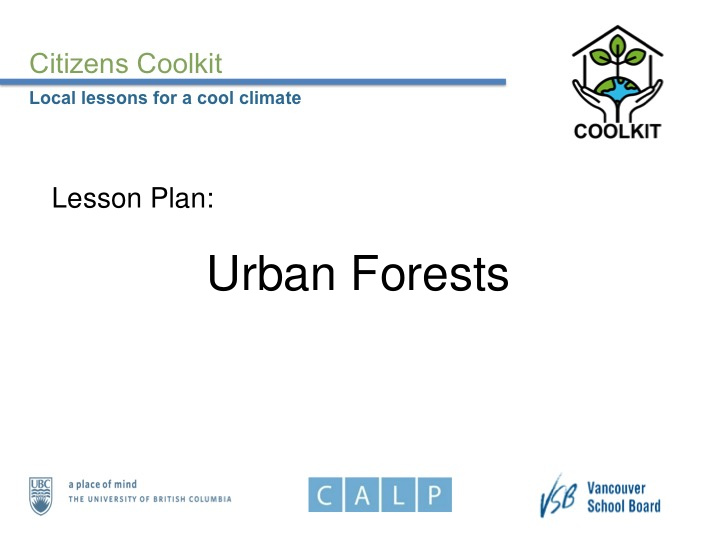



Lesson Plan: Urban Forests
Session 1
30 SECONDS What is a tree?
“a woody perennial plant, typically having a single stem or trunk growing to a considerable height and bearing lateral branches at some distance from the ground ”
Many unnoticed benefits
Try this: which are trees? Shrub Tree! Vine Tree! Dogwood Mangroves Wisteria Maple
Try this: Street trees… or garden trees?
Indicators of Climate Change Vulnerability What is an ‘urban forest’? What does it mean to you?
Indicators of Climate Change Vulnerability What is an ‘urban forest’? What does it mean to you? urban forest : includes a variety of vegetation and landscape types such as parks, streetscapes, natural areas, and private yards, which together form a complex system of urban greenery (Citizens Coolkit, 2018)
https://www.youtube.com/watch?v=iCy_m-u0VEM
Example: Community Gardens - Provide food to local residents - Support habitat for wildlife - Increase biodiversity - Increase storm water infiltration
WHY DO YOU THINK URBAN HOW DO THEY RELATE TO FORESTS ARE IMPORTANT? CLIMATE CHANGE?
Adapted from Sara Barron
Session 2
Exercise: Urban Forest Quest Profile the urban forest! Page 14 in the Coolkit
Exercise: Urban Forest Quest Profile the urban forest! You are employed by your school to conduct some research on the urban forest near your school.
Your employers want a brief report on: 1. The number of trees 2. The approximate size of the trees 3. Quality of the tree canopy Bonus : – Identify tree species! – Provide recommendations on how to improve the current situation
Instructions • Groups of 4-5 people • Each group has 1 copy of the Quest and 1 D-tape • Prize for the fastest and the most accurate group
Outdoor Quest Discussion Why are large tree canopies important to us, and not just to squirrels? – Create shade with canopies – Filter air through photosynthesis – Beautify houses and gardens with flowers and fruit – Increase habitat with leaves and branches
Session 3
Urban Forests in Vancouver • Vancouver Urban Forest Strategy • 90% of residents live within 5 minutes of a green space
18% of Vancouver is covered by tree canopy What is tree canopy ? Tree canopy is the space that the tree’s canopy takes up 11% on street 27% in parks 62% on private property
How ever, w e are losing healthy trees everyday… City canopy cover target: 22% 5 healthy mature trees removed everyday
Vancouver’s Tree Canopy Cover • Currently 18% but the goal is to increase it to 22% by 2020 • Plant 150, 000 trees • The location of where these trees are planted is important
Habitat Mapping Squirrel habitat • • Worm habitat • Car habitat • Pigeon habitat
Car habitat Squirrel habitat Worm habitat Pigeon habitat
Assess GREEN or GREY neighbourhoods Squirrel Pigeon habitat habitat Worm Car habitat habitat
GREEN GREY Pigeon habitat Squirrel habitat Car habitat Worm habitat
• file:///.file/id=13403643.409
What are the dominant habitats? Squirrel? Worm? Car? Pigeon?
Consider this: • For GREY sites, how will you become more GREEN? • For GREEN sites, how will you stay or become more GREEN?
Signs of Climate Change 2.3 Visioning Activity Example
Signs of Climate Change 2.3 Visioning Activity Some possibilities to consider: LOW CARBON FUTURE • More hard surface is converted to green space • A community garden/orchard is developed • Solar panels are installed • More bike lanes are in place OR HIGH CARBON FUTURE • Mature trees are gone (because of climate change • Streets are wider to allow for more cars • More street parking at or near your place • Potential flooding if close to sea-level
+ vegetation Food gardens Bee farms
walk + bike
–fossil fuel cars
2.4 Visioning Activity Find a partner and take turns interpreting each other’s visioning exercise. • What did they add or take away? • Is their imagined future more or less resilient than the present image? Why?
Visioning Examples Before After
Visioning Examples Before After
GREY to GREEN – trees
http://calp.forestry.ubc.ca/
Recommend
More recommend